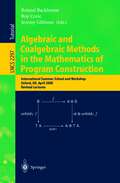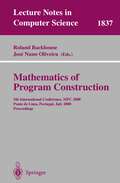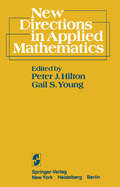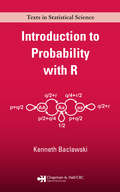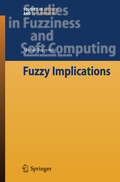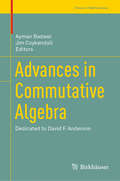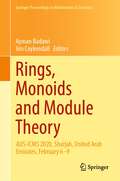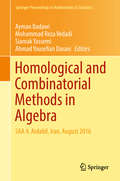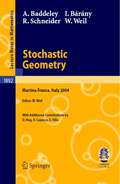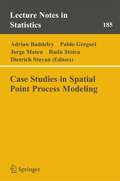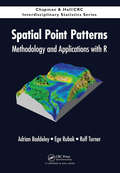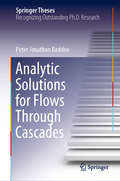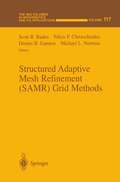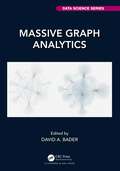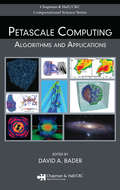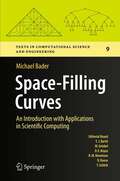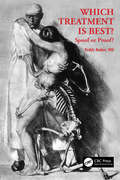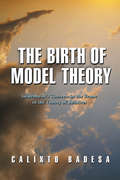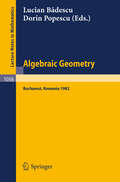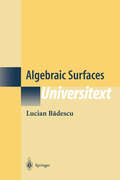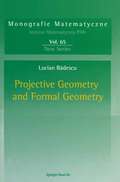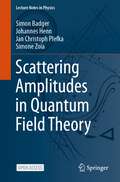- Table View
- List View
Algebraic and Coalgebraic Methods in the Mathematics of Program Construction: International Summer School and Workshop, Oxford, UK, April 10-14, 2000, Revised Lectures (Lecture Notes in Computer Science #2297)
by Roland Backhouse Roy Crole Jeremy GibbonsProgram construction is about turning specifications of computer software into implementations. Recent research aimed at improving the process of program construction exploits insights from abstract algebraic tools such as lattice theory, fixpoint calculus, universal algebra, category theory, and allegory theory.This textbook-like tutorial presents, besides an introduction, eight coherently written chapters by leading authorities on ordered sets and complete lattices, algebras and coalgebras, Galois connections and fixed point calculus, calculating functional programs, algebra of program termination, exercises in coalgebraic specification, algebraic methods for optimization problems, and temporal algebra.
Mathematics of Program Construction: 5th International Conference, MPC 2000 Ponte de Lima, Portugal, July 3-5, 2000 Proceedings (Lecture Notes in Computer Science #1837)
by Roland Backhouse Jose Nuno OliveiraThis volume contains the proceedings of MPC 2000, the ?fth international c- ference on Mathematics of Program Construction. This series of conferences aims to promote the development of mathematical principles and techniques that are demonstrably useful and usable in the process of constructing c- puter programs (whether implemented in hardware or software). The focus is on techniques that combine precision with concision, enabling programs to be constructed by formal calculation. Within this theme, the scope of the series is very diverse, including programming methodology, program speci?cation and transformation, programming paradigms, programming calculi, and progr- ming language semantics. The quality of the papers submitted to the conference was in general very high. However,the number of submissions has decreased compared to the pre- ous conferences in the series. Each paper was refereed by at least ?ve and often more committee members. In order to maintain the high standards of the c- ference the committee took a stringent view on quality; this has meant that, in some cases, a paper was rejected even though there was a basis for a good c- ference or journal paper but the submitted paper did not meet the committee’s required standards. In a few cases a good paper was rejected on the grounds that it did not ?t within the scope of the conference.
New Directions in Applied Mathematics: Papers Presented April 25/26, 1980, on the Occasion of the Case Centennial Celebration
by K. BaclawskiIt is close enough to the end of the century to make a guess as to what the Encyclopedia Britannica article on the history of mathematics will report in 2582: "We have said that the dominating theme of the Nineteenth Century was the development and application of the theory of functions of one variable. At the beginning of the Twentieth Century, mathematicians turned optimistically to the study off unctions of several variables. But wholly unexpected difficulties were met, new phenomena were discovered, and new fields of mathematics sprung up to study and master them. As a result, except where development of methods from earlier centuries continued, there was a recoil from applications. Most of the best mathematicians of the first two-thirds of the century devoted their efforts entirely to pure mathe matics. In the last third, however, the powerful methods devised by then for higher-dimensional problems were turned onto applications, and the tools of applied mathematics were drastically changed. By the end of the century, the temporary overemphasis on pure mathematics was completely gone and the traditional interconnections between pure mathematics and applications restored. "This century also saw the first primitive beginnings of the electronic calculator, whose development in the next century led to our modern methods of handling mathematics.
Introduction to Probability with R (Chapman And Hall/crc Texts In Statistical Science Ser.)
by Kenneth BaclawskiBased on a popular course taught by the late Gian-Carlo Rota of MIT, with many new topics covered as well, Introduction to Probability with R presents R programs and animations to provide an intuitive yet rigorous understanding of how to model natural phenomena from a probabilistic point of view. Although the R programs are small in length, they ar
Fuzzy Implications (Studies in Fuzziness and Soft Computing)
by Michał Baczyński Balasubramaniam JayaramAdvances in Commutative Algebra: Dedicated to David F. Anderson (Trends in Mathematics)
by Ayman Badawi Jim CoykendallThis book highlights the contributions of the eminent mathematician and leading algebraist David F. Anderson in wide-ranging areas of commutative algebra. It provides a balance of topics for experts and non-experts, with a mix of survey papers to offer a synopsis of developments across a range of areas of commutative algebra and outlining Anderson’s work. The book is divided into two sections—surveys and recent research developments—with each section presenting material from all the major areas in commutative algebra. The book is of interest to graduate students and experienced researchers alike.
Rings, Monoids and Module Theory: AUS-ICMS 2020, Sharjah, United Arab Emirates, February 6–9 (Springer Proceedings in Mathematics & Statistics #382)
by Ayman Badawi Jim CoykendallThis book contains select papers on rings, monoids and module theory which are presented at the 3rd International Conference on Mathematics and Statistics (AUS-ICMS 2020) held at the American University of Sharjah, United Arab Emirates, from 6–9 February 2020. This conference was held in honour of the work of the distinguished algebraist Daniel D. Anderson. Many participants and colleagues from around the world felt it appropriate to acknowledge his broad and sweeping contributions to research in algebra by writing an edited volume in his honor. The topics covered are, inevitably, a cross-section of the vast expansion of modern algebra. The book is divided into two sections—surveys and recent research developments—with each section hopefully offering symbiotic utility to the reader. The book contains a balanced mix of survey papers, which will enable expert and non-expert alike to get a good overview of developments across a range of areas of algebra. The book is expected to be of interest to both beginning graduate students and experienced researchers.
Homological and Combinatorial Methods in Algebra: SAA 4, Ardabil, Iran, August 2016 (Springer Proceedings in Mathematics & Statistics #228)
by Ayman Badawi Mohammad Reza Vedadi Siamak Yassemi Ahmad Yousefian DaraniBased on the 4th Seminar on Algebra and its Applications organized by the University of Mohaghegh Ardabili, this volume highlights recent developments and trends in algebra and its applications. Selected and peer reviewed, the contributions in this volume cover areas that have flourished in the last few decades, including homological algebra, combinatorial algebra, module theory and linear algebra over rings, multiplicative ideal theory, and integer-valued polynomials. Held biennially since 2010, SAA introduces Iranian faculty and graduate students to important ideas in the mainstream of algebra and opens channels of communication between Iranian mathematicians and algebraists from around the globe to facilitate collaborative research. Ideal for graduate students and researchers in the field, these proceedings present the best of the seminar’s research achievements and new contributions to the field.
Stochastic Geometry: Lectures given at the C.I.M.E. Summer School held in Martina Franca, Italy, September 13-18, 2004 (Lecture Notes in Mathematics #1892)
by A. Baddeley I. Bárány R. Schneider W. WeilStochastic Geometry is the mathematical discipline which studies mathematical models for random geometric structures. This book collects lectures presented at the CIME summer school in Martina Franca in September 2004. The main lecturers covered Spatial Statistics, Random Points, Integral Geometry and Random Sets. These are complemented by two additional contributions on Random Mosaics and Crystallization Processes. The book presents a comprehensive and up-to-date description of important aspects of Stochastic Geometry.
Case Studies in Spatial Point Process Modeling (Lecture Notes in Statistics #185)
by Adrian Baddeley Pablo Gregori Jorge Mateu Mahiques Radu Stoica Dietrich StoyanPoint process statistics is successfully used in fields such as material science, human epidemiology, social sciences, animal epidemiology, biology, and seismology. Its further application depends greatly on good software and instructive case studies that show the way to successful work. This book satisfies this need by a presentation of the spatstat package and many statistical examples. Researchers, spatial statisticians and scientists from biology, geosciences, materials sciences and other fields will use this book as a helpful guide to the application of point process statistics. No other book presents so many well-founded point process case studies. From the reviews: "For those interested in analyzing their spatial data, the wide variatey of examples and approaches here give a good idea of the possibilities and suggest reasonable paths to explore." Michael Sherman for the Journal of the American Statistical Association, December 2006
Spatial Point Patterns: Methodology and Applications with R
by Adrian Baddeley Ege Rubak Rolf TurnerModern Statistical Methodology and Software for Analyzing Spatial Point PatternsSpatial Point Patterns: Methodology and Applications with R shows scientific researchers and applied statisticians from a wide range of fields how to analyze their spatial point pattern data. Making the techniques accessible to non-mathematicians, the authors draw on th
Analytic Solutions for Flows Through Cascades (Springer Theses)
by Peter Jonathan BaddooThis thesis is concerned with flows through cascades, i.e. periodic arrays of obstacles. Such geometries are relevant to a range of physical scenarios, chiefly the aerodynamics and aeroacoustics of turbomachinery flows. Despite the fact that turbomachinery is of paramount importance to a number of industries, many of the underlying mechanisms in cascade flows remain opaque. In order to clarify the function of different physical parameters, the author considers six separate problems. For example, he explores the significance of realistic blade geometries in predicting turbomachinery performance, and the possibility that porous blades can achieve noise reductions. In order to solve these challenging problems, the author deploys and indeed develops techniques from across the spectrum of complex analysis: the Wiener–Hopf method, Riemann–Hilbert problems, and the Schottky–Klein prime function all feature prominently. These sophisticated tools are then used to elucidate the underlying mathematical and physical structures present in cascade flows. The ensuing solutions greatly extend previous works and offer new avenues for future research. The results are not of simply academic value but are also useful for aircraft designers seeking to balance aeroacoustic and aerodynamic effects.
Structured Adaptive Mesh Refinement (The IMA Volumes in Mathematics and its Applications #117)
by Scott B. Baden Nikos P. Chrisochoides Dennis B. Gannon Michael L. NormanThe papers presented here describe research to improve the general understanding of the application of SAMR to practical problems, to identify issues critical to efficient and effective implementation on high performance computers and to stimulate the development of a community code repository for software including benchmarks to assist in the evaluation of software and compiler technologies. The ten chapters have been divided into two parts reflecting two major issues in the topic: programming complexity of SAMR algorithms and the applicability and numerical challenges of SAMR methods.
Massive Graph Analytics (Chapman & Hall/CRC Data Science Series)
by David A. BaderExpertise in massive scale graph analytics is key for solving real-world grand challenges from health to sustainability to detecting insider threats, cyber defense, and more. Massive Graph Analytics provides a comprehensive introduction to massive graph analytics, featuring contributions from thought leaders across academia, industry, and government. The book will be beneficial to students, researchers and practitioners, in academia, national laboratories, and industry, who wish to learn about the state-of-the-art algorithms, models, frameworks, and software in massive scale graph analytics.
Massive Graph Analytics (Chapman & Hall/CRC Data Science Series)
by David A. BaderExpertise in massive scale graph analytics is key for solving real-world grand challenges from health to sustainability to detecting insider threats, cyber defense, and more. Massive Graph Analytics provides a comprehensive introduction to massive graph analytics, featuring contributions from thought leaders across academia, industry, and government. The book will be beneficial to students, researchers and practitioners, in academia, national laboratories, and industry, who wish to learn about the state-of-the-art algorithms, models, frameworks, and software in massive scale graph analytics.
Petascale Computing: Algorithms and Applications
by David A. BaderAlthough the highly anticipated petascale computers of the near future will perform at an order of magnitude faster than today's quickest supercomputer, the scaling up of algorithms and applications for this class of computers remains a tough challenge. From scalable algorithm design for massive concurrency toperformance analyses and scientific vis
Space-Filling Curves: An Introduction with Applications in Scientific Computing (Texts in Computational Science and Engineering #9)
by Michael BaderThe present book provides an introduction to using space-filling curves (SFC) as tools in scientific computing. Special focus is laid on the representation of SFC and on resulting algorithms. For example, grammar-based techniques are introduced for traversals of Cartesian and octree-type meshes, and arithmetisation of SFC is explained to compute SFC mappings and indexings.The locality properties of SFC are discussed in detail, together with their importance for algorithms. Templates for parallelisation and cache-efficient algorithms are presented to reflect the most important applications of SFC in scientific computing. Special attention is also given to the interplay of adaptive mesh refinement and SFC, including the structured refinement of triangular and tetrahedral grids. For each topic, a short overview is given on the most important publications and recent research activities.
Which Treatment Is Best? Spoof or Proof?
by Teddy BaderA young woman cries, "Please don’t let me die!" Has she received the best treatment? What is the best treatment? How do we know? Life-threatening disease prompts these questions in everyone. Which Treatment Is Best? Spoof or Proof? explains the best scientific evidence for any treatment—the randomized controlled trial. This book begins with rotten humors as the source of all diseases. The reader is guided through serious attempts in history to treat disease, but which now seem amusing. The story ends with the randomized controlled trial and how to interpret it. The text will help students and clinicians understand this universal language of clinical research worldwide. Key Features Describes the development of the randomized, controlled trial as the gold standard of proof Unravels the meaning of "randomized," "double-blind," and "p-values" in a simplified manner for students and clinicians Contains timeless information on how medical evidence can be understood
Which Treatment Is Best? Spoof or Proof?
by Teddy BaderA young woman cries, "Please don’t let me die!" Has she received the best treatment? What is the best treatment? How do we know? Life-threatening disease prompts these questions in everyone. Which Treatment Is Best? Spoof or Proof? explains the best scientific evidence for any treatment—the randomized controlled trial. This book begins with rotten humors as the source of all diseases. The reader is guided through serious attempts in history to treat disease, but which now seem amusing. The story ends with the randomized controlled trial and how to interpret it. The text will help students and clinicians understand this universal language of clinical research worldwide. Key Features Describes the development of the randomized, controlled trial as the gold standard of proof Unravels the meaning of "randomized," "double-blind," and "p-values" in a simplified manner for students and clinicians Contains timeless information on how medical evidence can be understood
The Birth of Model Theory: Löwenheim's Theorem in the Frame of the Theory of Relatives
by Calixto BadesaLöwenheim's theorem reflects a critical point in the history of mathematical logic, for it marks the birth of model theory--that is, the part of logic that concerns the relationship between formal theories and their models. However, while the original proofs of other, comparably significant theorems are well understood, this is not the case with Löwenheim's theorem. For example, the very result that scholars attribute to Löwenheim today is not the one that Skolem--a logician raised in the algebraic tradition, like Löwenheim--appears to have attributed to him. In The Birth of Model Theory, Calixto Badesa provides both the first sustained, book-length analysis of Löwenheim's proof and a detailed description of the theoretical framework--and, in particular, of the algebraic tradition--that made the theorem possible. Badesa's three main conclusions amount to a completely new interpretation of the proof, one that sharply contradicts the core of modern scholarship on the topic. First, Löwenheim did not use an infinitary language to prove his theorem; second, the functional interpretation of Löwenheim's normal form is anachronistic, and inappropriate for reconstructing the proof; and third, Löwenheim did not aim to prove the theorem's weakest version but the stronger version Skolem attributed to him. This book will be of considerable interest to historians of logic, logicians, philosophers of logic, and philosophers of mathematics.
The Birth of Model Theory: Löwenheim's Theorem in the Frame of the Theory of Relatives
by Calixto BadesaLöwenheim's theorem reflects a critical point in the history of mathematical logic, for it marks the birth of model theory--that is, the part of logic that concerns the relationship between formal theories and their models. However, while the original proofs of other, comparably significant theorems are well understood, this is not the case with Löwenheim's theorem. For example, the very result that scholars attribute to Löwenheim today is not the one that Skolem--a logician raised in the algebraic tradition, like Löwenheim--appears to have attributed to him. In The Birth of Model Theory, Calixto Badesa provides both the first sustained, book-length analysis of Löwenheim's proof and a detailed description of the theoretical framework--and, in particular, of the algebraic tradition--that made the theorem possible. Badesa's three main conclusions amount to a completely new interpretation of the proof, one that sharply contradicts the core of modern scholarship on the topic. First, Löwenheim did not use an infinitary language to prove his theorem; second, the functional interpretation of Löwenheim's normal form is anachronistic, and inappropriate for reconstructing the proof; and third, Löwenheim did not aim to prove the theorem's weakest version but the stronger version Skolem attributed to him. This book will be of considerable interest to historians of logic, logicians, philosophers of logic, and philosophers of mathematics.
Algebraic Geometry: Proceedings of the International Conference held in Bucharest, Romania, August 2–7, 1982 (Lecture Notes in Mathematics #1056)
by L. Badescu D. PopescuAlgebraic Surfaces (Universitext)
by Lucian BadescuThis book presents fundamentals from the theory of algebraic surfaces, including areas such as rational singularities of surfaces and their relation with Grothendieck duality theory, numerical criteria for contractibility of curves on an algebraic surface, and the problem of minimal models of surfaces. In fact, the classification of surfaces is the main scope of this book and the author presents the approach developed by Mumford and Bombieri. Chapters also cover the Zariski decomposition of effective divisors and graded algebras.
Projective Geometry and Formal Geometry (Monografie Matematyczne #65)
by Lucian BadescuThe aim of this monograph is to introduce the reader to modern methods of projective geometry involving certain techniques of formal geometry. Some of these methods are illustrated in the first part through the proofs of a number of results of a rather classical flavor, involving in a crucial way the first infinitesimal neighbourhood of a given subvariety in an ambient variety. Motivated by the first part, in the second formal functions on the formal completion X/Y of X along a closed subvariety Y are studied, particularly the extension problem of formal functions to rational functions. The formal scheme X/Y, introduced to algebraic geometry by Zariski and Grothendieck in the 1950s, is an analogue of the concept of a tubular neighbourhood of a submanifold of a complex manifold. It is very well suited to study the given embedding Y\subset X. The deep relationship of formal geometry with the most important connectivity theorems in algebraic geometry, or with complex geometry, is also studied. Some of the formal methods are illustrated and applied to homogeneous spaces.The book contains a lot of results obtained over the last thirty years, many of which never appeared in a monograph or textbook. It addresses to algebraic geometers as well as to those interested in using methods of algebraic geometry.
Scattering Amplitudes in Quantum Field Theory (Lecture Notes in Physics #1021)
by Simon Badger Johannes Henn Jan Christoph Plefka Simone ZoiaThis open access book bridges a gap between introductory Quantum Field Theory (QFT) courses and state-of-the-art research in scattering amplitudes. It covers the path from basic definitions of QFT to amplitudes, which are relevant for processes in the Standard Model of particle physics. The book begins with a concise yet self-contained introduction to QFT, including perturbative quantum gravity. It then presents modern methods for calculating scattering amplitudes, focusing on tree-level amplitudes, loop-level integrands and loop integration techniques. These methods help to reveal intriguing relations between gauge and gravity amplitudes and are of increasing importance for obtaining high-precision predictions for collider experiments, such as those at the Large Hadron Collider, as well as for foundational mathematical physics studies in QFT, including recent applications to gravitational wave physics.These course-tested lecture notes include numerous exercises with solutions. Requiring only minimal knowledge of QFT, they are well-suited for MSc and PhD students as a preparation for research projects in theoretical particle physics. They can be used as a one-semester graduate level course, or as a self-study guide for researchers interested in fundamental aspects of quantum field theory.
